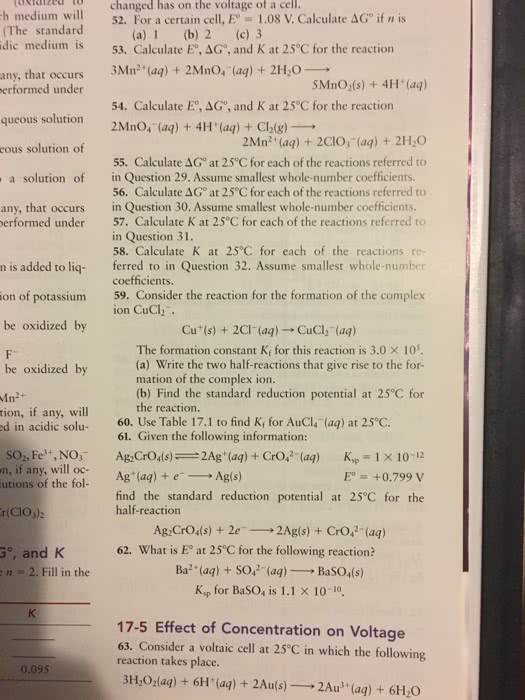Heart pacemakers are often powered by lithium–silver chromate “button” batteries.
The overall cell reaction is
2 Li(s) + Ag2CrO4(s)→ Li2CrO4(s) + 2Ag(s)
(a) Lithium metal is the reactant at one of the electrodes of the battery. Is it the anode or the cathode? (b) Choose the two half-reactions from Appendix E that most closely approximate
the reactions that occur in the battery. What standard emf would be generated by a voltaic cell based on these half reactions? (c) The battery generates an emf of + 3.5 V. How close is this value to the one calculated in part (b)? (d) Calculate the emf that would be generated at body temperature, 37 °C. How does this compare to the emf you calculated in part (b)?
One Class Solution:-a) Li(s) is oxidized at the anode.
Ag2CrO4(s)+ 2e-→ 2Ag(s) + CrO42-(aq), E= 0.446V
Li(s) → Li+(aq)+e- E=–3.05V
2 Li(s) + Ag2CrO4(s)→ Li2CrO4(s) + 2Ag(s)
b) E0=0.446V-(-3.05V) =3.496=3.50V
c) The emf of the battery, 3.5 V, is exactly the standard cell potential calculated in part (b).
d) For this battery at ambient conditions, E0= E0, so logQ=O. This makes sense because all reactants and products in the battery are solids and thus present in their standard states. Assuming that E0 is relatively constant with temperature, the value of the second termin the Nernst equation is= 0 at 37°C, and E=3.5V.
Heart pacemakers are often powered by lithium–silver chromate “button” batteries.
The overall cell reaction is
2 Li(s) + Ag2CrO4(s)→ Li2CrO4(s) + 2Ag(s)
(a) Lithium metal is the reactant at one of the electrodes of the battery. Is it the anode or the cathode? (b) Choose the two half-reactions from Appendix E that most closely approximate
the reactions that occur in the battery. What standard emf would be generated by a voltaic cell based on these half reactions? (c) The battery generates an emf of + 3.5 V. How close is this value to the one calculated in part (b)? (d) Calculate the emf that would be generated at body temperature, 37 °C. How does this compare to the emf you calculated in part (b)?
One Class Solution:-a) Li(s) is oxidized at the anode.
Ag2CrO4(s)+ 2e-→ 2Ag(s) + CrO42-(aq), E= 0.446V
Li(s) → Li+(aq)+e- E=–3.05V
2 Li(s) + Ag2CrO4(s)→ Li2CrO4(s) + 2Ag(s)
b) E0=0.446V-(-3.05V) =3.496=3.50V
c) The emf of the battery, 3.5 V, is exactly the standard cell potential calculated in part (b).
d) For this battery at ambient conditions, E0= E0, so logQ=O. This makes sense because all reactants and products in the battery are solids and thus present in their standard states. Assuming that E0 is relatively constant with temperature, the value of the second termin the Nernst equation is= 0 at 37°C, and E=3.5V.

